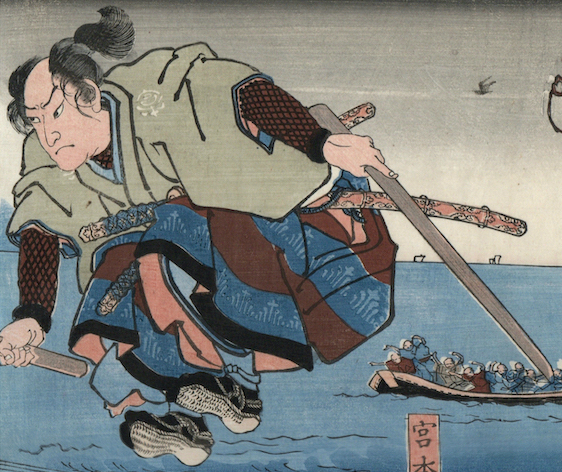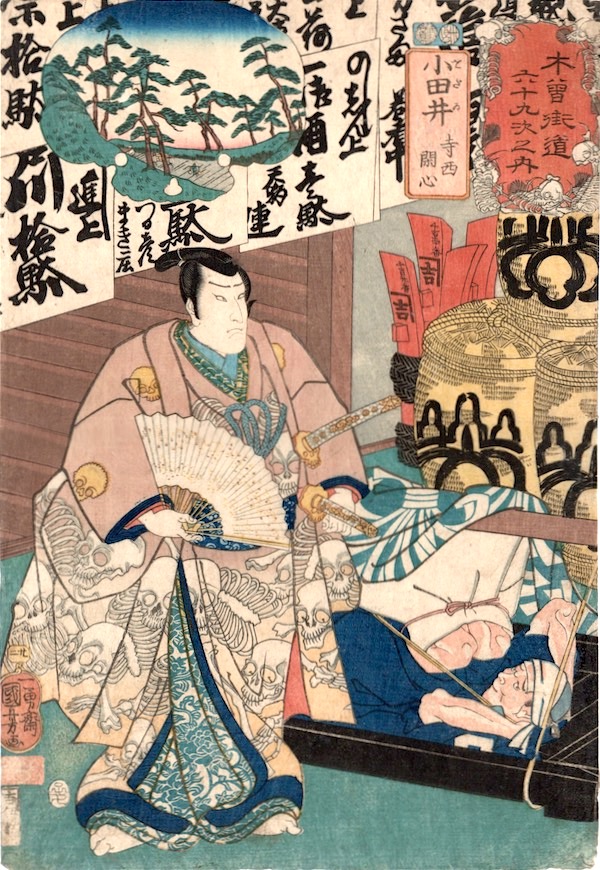Kuniyoshi Prints at Toshidama Gallery
Here is a fantastic triptych woodblock print by the great Japanese woodblock print artist, Utagawa Kuniyoshi. What’s going on? Well, it is a portrait of one of the most revered of the Japanese sword masters, Miyamoto Musashi.
Musashi was born in 1584 and died in 1645. His fame and skill are so highly valued that he is considered a ‘sword-saint’ in Japan even today. He held an undefeated record sixty-two duels and died not from violence but from old age. In old age, he wrote the famous text, The Book of the Five Rings which is a kind of manual and philosophy of fighting, notably advocating holding a sword in each hand when fighting opponents. This feature of his fighting style is shown in the Kuniyoshi print. A sword for hire, it is presumed that Musashi fought on the Tokugawa side during the key battles of the civil war period.
The event that makes up the subject of the Kuniyoshi print occurred in 1611 or 1612. A duel had been arranged between Musashi and a rival swordsman, Sasaki Kojiro. The reasons given for the duel vary, but it may be presumed that the duel was held to establish who was the better swordsman. The duel took place on Ganryujima, a small island accessible only by boat and the two men were directed by a local lord to arrive there at a certain date and time.
Above in the detail, we can see the grim fate of Musashi’s opponent Kojiro… his skull cleaved in two by a wooden sword. Musashi had made two long wooden swords out of a boat oar on his way to the duel. Kuniyoshi shows us the superior fighting skill of Musashi, pictures his athleticism and calm, controlled features, contrasted with Kojiro’s angry, contorted face and flailing sword. The moment is the moment of death. The wooden sword has just made contact with Kojiro’s head and will cleave it in two. A crowd of onlookers fill right hand sheet and boats crowded with figures drift out in the sea.
There is a suggestion in some texts that the duel came about because Musashi was avenging the death of his father at the hands of Kojiro. It would explain the brutality and the humiliation of death from a sword whittled from a boat oar, and of course it is suggested in the title of the print… Vengeance at Ganryujima. In The Book of the Five Rings, Musashi writes:
There is timing in the whole life of the warrior, in his thriving and declining, in his harmony and discord. Similarly, there is timing in the Way of the merchant, in the rise and fall of capital. All things entail rising and falling timing. You must be able to discern this. In strategy there are various timing considerations. From the outset you must know the applicable timing and the inapplicable timing, and from among the large and small things and the fast and slow timings find the relevant timing, first seeing the distance timing and the background timing. This is the main thing in strategy. It is especially important to know the background timing, otherwise your strategy will become uncertain.
The Book of the Five Rings, which deals with sword fighting as philosophy, is a surprisingly popular text. The book is constantly in print and widely translated. In the world of business management its discussions and thoughts on strategy and conflict are often used in training sessions. I was entertained to perceive a similarity with much of Musashi’s musings and that of the fictional sword master and fencing teacher Syrio Forel (above) from the HBO series, Game of Thrones, season 1. Not only that, in the drama, Forel extols the virtues of holding two swords… one in each hand, exactly as Musashi does in his instructions! It is tempting to think that Musashi was an inspiration to the screenwriters. Here is one of many quotes written for the character of Forel that could easily have come from the Book of the Five Rings. As a teacher, note how he defeats the iron clad Palace Guard with only a wooden training sword!
Opening your eyes is all that is needed. The heart lies and the head plays tricks with us, but the eyes see true. Look with your eyes. Hear with your ears. Taste with your mouth. Smell with your nose. Feel with your skin. Then comes the thinking, afterward, and in that way knowing the truth.
Also in the Summer selection at the Toshidama Gallery is this fine piece. An extraordinary compendium of shapes, textures, patterns, signs and symbols all colliding in a strange three dimensional and oddly flattened space… what a triumph of design this is and its crowning glory is the motif of grinning skulls! Also by Kuniyoshi, this print is from the great series of prints about the stations on the Kisokaido Road in Japan. I count twenty separate skulls on here… including the main cartouche which also shows a snapshot of the route itself. Note the tiny skeletons that surround the red cartouche in the upper right.
The Kisokaidô Road was an inland route connecting Edo (present day Tokyo) with Kyoto. (The coastal route between Edo and Kyoto was the Tokaido Road.) There were sixty-nine rest stops along the Kisokaido Road. In this series, Kuniyoshi designed one print for each of the sixty-nine rest stops plus prints for Edo and Kyoto, as well as a title page. The main design of each print portrays a historical, legendary of fictional scene associated with the location. A small panel in each print shows a view of the station. This series of prints of the Kisokaido was a response to the increased demand for mitate, or puzzle pictures based around travel. Censorship that forbade all actor portraits and proscribed many historical figures did not apply to the types of travel picture made popular by Hiroshige in the 1830’s. Kunisada started a craze for these travel pictures that happened also to feature actors or other subject (usually unnamed). Kuniyoshi was much less of a theatre artist than Kunisada and his ‘travel’ series tend more to play to his strengths as an illustrator of myth and legend, as is apparent in this print.
Here is a great mystery in some respects… an elaborate series of hoaxes and insults are being played out in a nod to the delicately titled kabuki drama: Banzui Chobei’s Vegetarian Chopping Block. The figure in the magnificent robes lavishly decorated with skulls is Teranishi Kanshin. The figure in the contorted pose at his feet is his follower, Dotesuke. Dotesuke has been injured by the grocer Chobei’s son. The wealthy Kansin creates an elaborate insult by dressing the hapless Dotesuke as a giant carp and presenting him at a memorial feast for Chobei’s family… a feast that is strictly vegetarian. In a harsh response to this subtle elaborate hoax, Chobei puts his own son on a chopping block and sends him to Kanshin with the instruction to do with him as he pleases. Kanshin is so moved that the two become firm friends… no, I do not understand the ‘insult’ either!
The Summer Selection is at the Toshidama Gallery online from 14th of June 2024
Why not join our mailing list for monthly discounts on all prints?







